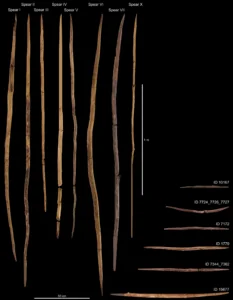
Why in news?
- For generations, the Stone Age has been synonymous with crude stone tools and a rudimentary human existence.
- However, recent discoveries are challenging this long-held perception.
- Evidence from Germany suggests the Stone Age might be more accurately described as the “Wood Age,” highlighting the crucial role wood played in the lives of our early ancestors.
Unearthing the Past: Wooden Artifacts Rewrite History
- The game-changer came in the form of well-preserved wooden artifacts unearthed in Schöningen, Germany.
- Dating back an impressive 300,000 to 400,000 years, these finds shed light on a previously underestimated aspect of prehistoric life: sophisticated woodworking skills.
Beyond Sharpened Sticks: A Diverse Toolkit
- These artifacts were far from mere sharpened sticks. Analysis revealed a diverse range of woodworking techniques employed by early humans.
- Evidence suggests they used scraping, splitting, and even heat treatment to shape wood for various purposes.
Hunting Tools and Beyond: Unveiling Human Capabilities
- The discovery of sophisticated wooden hunting tools, such as thrusting spears, challenges the notion of early humans as simple scavengers.
- These artifacts point towards a more complex reality – one where humans engaged in strategic hunting, planned their activities, and demonstrated remarkable technological adaptability through tool repair and reuse.
Preservation Bias: Stone vs. Wood
- The importance of these wooden artifacts goes beyond their individual functions.
- Their very existence highlights a potential bias in archaeology. Stone, being more durable, has traditionally received greater focus in the archaeological record.
- This can create a skewed understanding of our past, potentially underestimating the importance of wood in prehistoric times.
A Look Back: The Stone Age in Context
- So, what exactly was the Stone Age? It began roughly 3.4 million years ago in modern-day Ethiopia with the first use of stone tools by hominids.
- This period, encompassing a staggering 99% of human history, witnessed significant advancements in human evolution and tool use.
India’s Stone Age Journey
- India’s diverse landscape provided a rich habitat for early human settlements during the Stone Age.
- The Indian subcontinent, excluding the Himalayas and the Indo-Gangetic plains, was home to various Stone Age cultures.
- The Indian Palaeolithic period itself is divided into three distinct stages:
- Lower Palaeolithic (600,000 – 150,000 years BP): Large stone tools like hand axes, cleavers, and choppers dominated this period.
- Middle Palaeolithic (165,000 – 31,000 years BP): This phase saw the development of a wider variety of tools, including scrapers, points, and borers, made from flakes struck from cores.
- Upper Palaeolithic (40,000 – 12,000 years BP): This period witnessed further advancements in tool technology, with the creation of blunted blades, penknife blades, serrated blades, and arrow points.
Beyond the Stone Age: A Broader Spectrum
- The Stone Age eventually transitioned into the Mesolithic period, characterized by the use of microlithic tools for hunting smaller prey.
- This era also saw the development of semi-permanent settlements, burial rituals, and artistic expression. Finally, the Neolithic period marked the dawn of agriculture and animal domestication.
Conclusion
- The discovery of sophisticated wooden artifacts in Schöningen prompts us to re-evaluate our understanding of the Stone Age.
- The “Wood Age” moniker serves as a reminder of the crucial role wood played in the lives of early humans.
- As we continue to explore and analyze archaeological finds, the lines between the Stone Age and the Wood Age may well blur, creating a more nuanced picture of our prehistoric past.
People also ask
Q1: Why are we questioning the traditional view of the Stone Age?
Ans: Recent discoveries of well-preserved wooden artifacts in Schöningen, Germany, challenge the idea that early humans only used crude stone tools. These finds suggest they possessed sophisticated woodworking skills, prompting the idea that the Stone Age might be more accurately termed the “Wood Age.”
Q2: What makes the Schöningen artifacts so significant?
Ans: Dating back 300,000 to 400,000 years, these artifacts represent the most well-preserved collection of prehistoric wooden tools ever discovered. They showcase a diverse range of woodworking techniques, including scraping, splitting, and even heat treatment.
Q3: How did these artifacts change our understanding of early humans?
Ans: The discovery reveals that early humans weren’t just simple scavengers. The presence of sophisticated hunting tools like spears suggests they engaged in strategic hunting, planned activities, and demonstrated remarkable technological skills through tool repair and reuse.
Q4: How does this discovery relate to Native Americans?
Ans: Similar to the discoveries in Germany, studying the Native Americans can provide insights into sophisticated woodworking and tool-making techniques that have been overlooked due to preservation bias. By examining artifacts beyond stone tools, we can gain a fuller understanding of their technological and cultural advancements.
Your point of view caught my eye and was very interesting. Thanks. I have a question for you.
Your article helped me a lot, is there any more related content? Thanks!